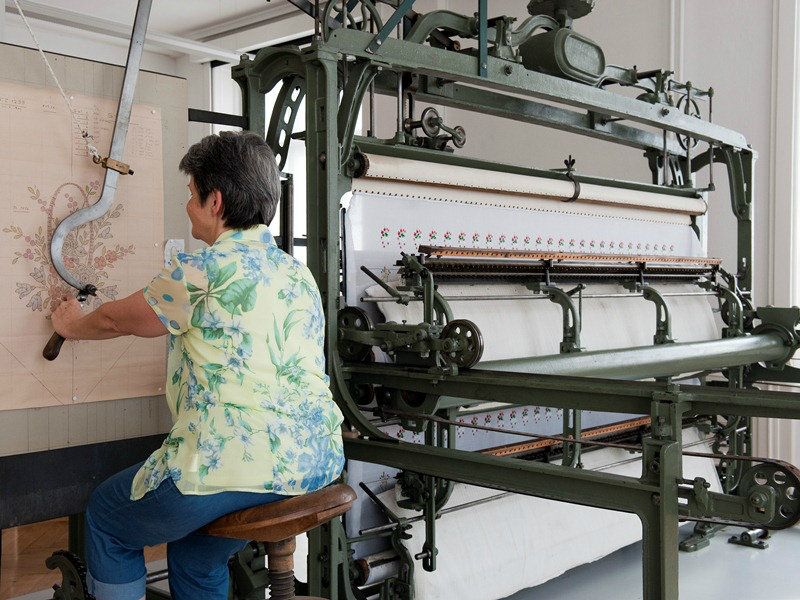Today six of us gathered for a private tour of the Textilmuseum. The collection contains items documenting the history of fabric production, with particular emphasis on the booming embroidery industry based in St. Gallen in the late 19th century. This was enabled by the invention of the hand-embroidery machine in 1828, leading to a boom economy post-1860. While many of these machines were used in factories, in Switzerland embroidery production remained for many a cottage industry (a stark contrast to the weaving industry in England). A family, often farmers, would borrow the funds to buy a hand-embroidery machine. The man of the family would operate the equipment (traditionally, embroidery had been an entirely female art) while the women and children threaded and inserted the hundreds of needles necessary to operate the machine. The museum features a training model of a hand-embroidery machine from circa 1890. Only half the size of an industrial model, it is 2.25 meters long and utilizes 156 needles. We didn't get to see it in operation, but the museum provides a demonstration of it in action in the afternoons on Thursday, Friday, and select Saturdays.
 |
| Training model of a hand-embroidery machine, circa 1890. |
 |
| Cotton machine embroidery from St. Gallen, circa 1900. In imitation of Irish crochet lace. |
Of particular interest to scholars of Jane Austen and the Regency Era in England were examples of whitework on muslin, extremely popular at the time. There was a gorgeous whiteworked gown on display from the late 1820's/early 1830s, after Austen's time but still of a similar silhouette to those of the earlier part of the century. The sleeves and skirt are fuller, moving towards the styles associated with the Victorian Era, but the Empire waistline is still the most distinguishing feature of the gown.
 |
| Cotton dress featuring hand embroidery from Eastern Switzerland, circa 1826-1830. |
After leaving the museum we did a quick tour of the Christmas market in St. Gallen. The Sternenstadt runs through the 23rd of December. St. Gallen is always beautiful, but the spectacle of the market at night, which is decorated by 700 star ornaments dangling above the streets, ought to be particularly scenic. Thanks for all who were able to join us. Our next meeting will be sometime in the spring and probably to the Napoleon Museum in Thurgau. More info to come!
Sources:
Campbell, Gordon. The Grove Encyclopedia of Decorative Arts, Volume One. Oxford University Press, 2006.
Ward, Gerald W.R. The Grove Encyclopedia of Materials and Techniques in Art. Oxford University Press, 2008.
Wikipedia contributors. "St. Gallen embroidery." Wikipedia, The Free Encyclopedia. Wikipedia, The Free Encyclopedia, 1 Jul. 2017. Web. 2 Dec. 2017.
Wikipedia contributors. "Textile manufacture during the Industrial Revolution." Wikipedia, The Free Encyclopedia. Wikipedia, The Free Encyclopedia, 27 Nov. 2017. Web. 2 Dec. 2017.
